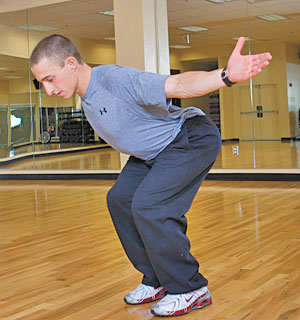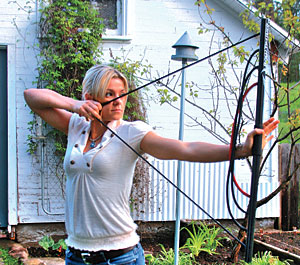Bowhunting Exercises: Back and Shoulders
Article reprinted from Bowhunter.com, by Dan Staton
On a hunt last year for Bowhunter TV, I had a bull elk in my lap for over three minutes, while all the brush in the state of Montana conspired against me as it hid the bull’s vitals. My muscles quivered as I held perfectly still at full draw and the bull glared holes through me and cameraman Larry D. Jones.
Sound familiar? All too often, hunting season arrives and you find out you’ve lost some shooting strength and stamina. As a result, your accuracy suffers. A strong draw and solid anchor hinges upon developed muscles of the back and shoulders coupled with muscle memory. Fortunately, a preemptive strike can ward off the strength and stamina loss.
Pillars Of Draw
The shoulders and upper back are the pillars of a solid draw and aim. These muscle groups are also prone to injury, so before chronic aches and pains strike — or maybe even surgery to repair shoulder damage — build strong pillars.
To do so, you must optimize range of motion in all of your joints. That involves exercises that help correct problems created by your life outside of hunting. Most of us spe nd long hours hunched over a computer, and if that is you, inevitably your shoulders will roll forward and tighten.
nd long hours hunched over a computer, and if that is you, inevitably your shoulders will roll forward and tighten.
That’s bad enough, but it gets worse if you go right out after work and shoot your bow. Shoulders tight from deskwork lack the necessary stability and range of motion for safely drawing a bow. However, your body has a knack for compensating, and it recruits more of your rotator cuff as you hold the bow up and pull the string. That, combined with poor joint alignment caused by poor posture at work, could produce a nasty case of shoulder impingement or upper back spasms.
About 65 percent of injuries — both athletic and lifestyle-related — are caused from overuse, which is to say from repetitive use of joints compromised by lousy posture and weak muscles. The following exercises help you draw a bow smoothly and powerfully while reducing the risk of injury. Perform the following exercises weekly. The number of reps and sets depends on your current fitness level. Start out slowly and progress over time.
Prone T’s
This exercise improves shoulder stability, strengthens the rotator cuffs, improves scapular strength, and increases muscle recruitment patterns.
To perform the exercise, pull your shoulder blades in toward your spine and extend your arms to the sides to create a T with your torso. Keep your arms long and straight, 90 degrees to your torso. Point your thumbs up, toward the ceiling. Keep your head in line with your spine. Keep your shoulder blades back and down, trying to squeeze them together. You should feel the contraction in the backs of your shoulders and in your upper back between the shoulder blades.
BowTrainer
Place your feet shoulder width apart with an open stance, as if shooting your bow. Grasping an exercise band in both hands, hold your bow arm in line with your shoulders and your bow hand at shoulder height. With three fingers of the draw hand, pull the band with your draw arm to your anchor position while keeping your draw arm in line with your shoulders.
Start with a light band, and pull it until you reach your approximate draw length. While drawing the band back past your jaw, try to get the band to the tip of your nose, or the corner of your mouth, to create an extra reference point. Complete three sets of 8-12 repetitions at your full draw length. Rest one minute between sets.
Work up in band strength, and only incorporate the red “power band” after several weeks of training. When using the red band, only pull back to half of your draw length.
Above all, build strength over time. Trying to pull too much too soon could strain and damage your shoulders.



